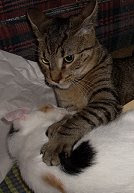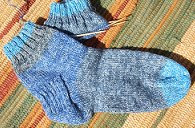
Today's Art of the Day from the website Art and the Bible (http://www.artbible.info/) is Caravaggio's version of Supper at Emmaus painted in 1606. This is Caravaggio's second version of the subject. He painted an earlier one in 1601.

One of Rembrandt's versions of this subject (http://www.artbible.info/art/large/342.html) was featured on Art of the Day on 9/2/08. This one was done in 1628. Rembrandt did two other versions in 1648.
These paintings illustrate one part of one of my favorite Bible passages, Luke 24: 13-35, the story of the two disciples walking to Emmaus after Jesus' crucifixion and the things that happen to them on the way and after their arrival there.
It was the morning of the Resurrection, Easter Sunday. Two disciples walk from Jerusalem to the town of Emmaus about seven miles away. Along the way, they discuss the events that have transpired since the arrest and execution of their beloved teacher, Jes
 us. As they walk along, they are overtaken by another traveler who listens in on their conversation and and asks them what they are talking about (here is a Rembrandt drawing to the right). They cannot believe that someone who has been in Jerusalem for the past few days cannot know about the things that have been going on there. They cannot comprehend why these things have happened and that some of the women among their group have reported that Jesus was alive, risen from the dead. Then the stranger chides them for not being able to understand the significance of the events that have taken place. With great authority he begins to explain to them how the events are the fulfillment of earlier scripture foretelling what must happen to the Christ. They listen attentively, hanging on his every word, amazed at his knowledge, and eager for more. When they reach Emmaus, the stranger says he must go on his way, but the two disciples beg him to stay with them and have supper. When the str
us. As they walk along, they are overtaken by another traveler who listens in on their conversation and and asks them what they are talking about (here is a Rembrandt drawing to the right). They cannot believe that someone who has been in Jerusalem for the past few days cannot know about the things that have been going on there. They cannot comprehend why these things have happened and that some of the women among their group have reported that Jesus was alive, risen from the dead. Then the stranger chides them for not being able to understand the significance of the events that have taken place. With great authority he begins to explain to them how the events are the fulfillment of earlier scripture foretelling what must happen to the Christ. They listen attentively, hanging on his every word, amazed at his knowledge, and eager for more. When they reach Emmaus, the stranger says he must go on his way, but the two disciples beg him to stay with them and have supper. When the str anger blesses and breaks the bread, their eyes are opened and they recognize him for who he truly is, Jesus the Lord, but just as they become aware of his identity, he vanishes from their sight (the Rembrandt drawing at the left). They speak of how their hearts burned within them as he spoke to them on the road and opened the scriptures to them. They decide to hurry back to Jerusalem right then to tell the other disciples of the experience. They find the others gathered together, saying that the Lord has risen and appeared to Simon. Then the two tell them about the events on the way to Emmaus and how Jesus was known to them in the breaking of the bread.
anger blesses and breaks the bread, their eyes are opened and they recognize him for who he truly is, Jesus the Lord, but just as they become aware of his identity, he vanishes from their sight (the Rembrandt drawing at the left). They speak of how their hearts burned within them as he spoke to them on the road and opened the scriptures to them. They decide to hurry back to Jerusalem right then to tell the other disciples of the experience. They find the others gathered together, saying that the Lord has risen and appeared to Simon. Then the two tell them about the events on the way to Emmaus and how Jesus was known to them in the breaking of the bread.| |
These four paintings all depict the reactions of the two disciples after they discover who their companion is. Here are the other two that Rembrandt did in 1648.


In all four of the paintings, the two disciples react with awe and amazement. In the paintings, they are shown variously throwing their hands up, gripping the table, looking awe-struck, and in one of the Rembrandts, one of them is kneeling in the shadows at the feet of Jesus.
I get excited when I read this story. I think about how the disciples said that hearing Jesus speak and explain the scriptures to them made their hearts burn within them. That is the way it should be. We should experience that burning excitement in our hearts when we hear or read scripture. Then in the breaking of the bread Jesus was made known to them. Yes! I think of the whole experience of the Mass, including the Liturgy of the Word with the scripture readings and the Liturgy of the Eucharist with the Eucharistic Prayer, the Fraction Rite (the Breaking of the Bread), and Holy Communion. The words, "Take this, all of you, and eat it; this is my body which will be given up for you." During the Mass, the bread is blessed and broken just as Jesus did at the Last Supper and at the Supper at Emmaus. A hymn that we sometimes sing says,"We remember, we celebrate, we believe." We do this each time we attend Mass: remember, celebrate, believe. Our hearts burning within us, He is made known to us in the breaking of the bread.
For more information:
http://catholic-resources.org/ChurchDocs/EP1-4.htm
http://www.newadvent.org/cathen/03255c.htm
http://www.catholic.org/prayers/mass.php
http://www.stagnescathedral.org/Parish/mass/mass.htm
http://www.sttoms-purdue.org/Liturgy2/liturgy/guide%20through%20mass.htm
I could not find publication information for the hymn, "We Remember" at this time.
All art is from Art and the Bible http://www.artbible.info
















































